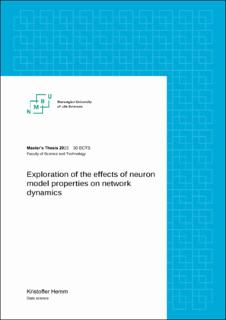| dc.description.abstract | The human brain is a complex system, consisting of over 80 billion neurons and the connection between these neurons. Due to the complexity of the brain, we are still far away from successfully being able to simulate the brain in detail. With modern computational technology we must make the tradeoff between modelling the neurons in detail, at the expense of network size, or to reduce the complexity of the neuron model in order to simulate a larger network. When making simplifications in modelling neural networks, modelers have different mathematical models at their disposal. One potential challenge in computational neuroscience is that different research groups may use different models in their effort to model the same phenomenon. In this thesis we explore how using different mathematical models to model the synapse between neurons may affect the dynamics in a network of neurons. For our work we use the integrate-and-fire neuron model, where the neurons are arranged in a Brunel network. We use three different waveform functions to model the current in the synapses between neurons. These include the delta function, the alpha function, and the exponential decay function. The dynamics of the networks are explored using spiking statistics that include the firing rate, the coefficient of variation, the correlation coefficient and Wasserstein distances. We explore the dynamics in networks of different sizes and in different firing regimes, keeping all parameters fixed. Our results show that the alpha synapse model have the highest firing rate in all regimes and network sizes. The exponential decay synapse model has the lowest firing rate in all regimes and network sizes, and the firing rate of the delta synapse model fall in between. The results also give an indication the separation into clearly defined firing regimes may not be as consistent as reported by others. All three synapse models are able to clearly separate between the regular and irregular regimes, but they all display difficulty in separating the between the irregular regimes. | |
